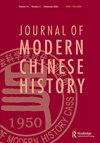Coming home to China: Margaret Woo’s story
IF 0.1
4区 历史学
Q4 HISTORY
引用次数: 0
Abstract
ABSTRACT This study uses a historical approach that gives context to transnational and gender issues. It investigates how a second-generation Chinese-American woman negotiated her identity as she moved to China and then back to the United States. Margaret Woo (1912–1982) was born in China and emigrated to the U.S. with her mother in 1914. Her father, Woo Du Sing, had done so around 1882 and settled in Minneapolis, Minnesota, where he owned a restaurant. Du Sing was a classic sojourner: he had a house built in his Chinese home village and intended to retire there. He died in Minneapolis in 1935, however, and his family returned to China to bury his body there and to live in that house. As a young woman raised in America, Margaret disliked village life and left for nearby Canton to become a student at Lingnan University. She returned to the U.S. in late 1937 to escape the Japanese. This study is based on primary sources including interviews with Woo family members in China and the U.S., Margaret’s diary from her time in China, artifacts such as the Woo family house in Kaiping, and a collection of cheongsam (qipao) dresses owned by Margaret Woo, and Lingnan University records. Historiographic issues addressed include the so-called sojourner hypothesis, which does much to explain the transnational nature of early 20th century overseas Chinese, who built houses in their home villages; also taken up is the role of fashion in exemplifying Chinese feminism and modernity, and the assimilation of second-generation Chinese-American female immigrants into American life.回到中国:吴曼玉的故事
本研究采用历史方法,为跨国和性别问题提供背景。它调查了一名第二代华裔美国女性在搬到中国然后回到美国的过程中如何协商自己的身份。吴宇森(1912-1982)出生于中国,1914年随母亲移民美国。她的父亲吴杜成(Woo Du Sing,音)在1882年左右移居美国,在明尼苏达州的明尼阿波利斯定居下来,在那里开了一家餐馆。杜兴是一个典型的旅居者:他在中国老家建了一所房子,打算在那里退休。然而,他于1935年在明尼阿波利斯去世,他的家人回到中国,将他的遗体埋在那里,并住在那所房子里。作为一个在美国长大的年轻女子,玛格丽特不喜欢乡村生活,于是前往附近的广州,就读岭南大学。1937年底,她为了躲避日本人回到美国。本研究的主要资料来源包括对吴氏家族在中国和美国成员的访谈、吴氏在中国期间的日记、吴氏在开平的住宅、吴氏的旗袍收藏以及岭南大学的记录等。讨论的史学问题包括所谓的“旅居假说”(sojourner hypothesis),该假说在很大程度上解释了20世纪早期海外华人在家乡建房的跨国性质;她还讨论了时尚在体现中国女权主义和现代性方面的作用,以及第二代美籍华裔女性移民融入美国生活的问题。
本文章由计算机程序翻译,如有差异,请以英文原文为准。
求助全文
约1分钟内获得全文
求助全文

 求助内容:
求助内容: 应助结果提醒方式:
应助结果提醒方式:


